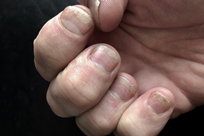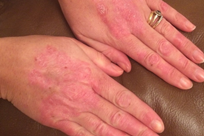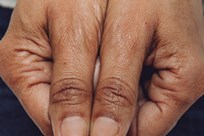Nail Psoriasis
Nail psoriasis is very common amongst both people with psoriasis and psoriatic arthritis.
About nail psoriasis
Nail psoriasis affects up to half of
all people with psoriasis and it is thought that around 80% of those with psoriatic
arthritis have nail symptoms. Nail
psoriasis can affect either fingernails or toenails, or both. As with other kinds of psoriasis, nail psoriasis may go through phases of being better and then worse again. It is possible
for a person to just have psoriasis of the nails, with no other psoriasis on the skin.
What are the main signs and symptoms of nail psoriasis?
Nail psoriasis can
range from mild to severe, and it is easy to misdiagnose as a fungal infection.
Any of the following signs may suggest nail psoriasis:
- Loss of the nail's usual healthy look, shape and feel
- Discolouration of the nail
- ‘Pitting’ (small dents) across the surface of the nail
- Nails that split or crumble easily
- Thickening of the nail
- Nails that lift or detach themselves from the nail bed - known as onycholosis
Nail psoriasis is not just a cosmetic problem, and should be appropriately treated by a healthcare professional such as a doctor or nurse. In moderate to severe cases, nail psoriasis can be painful and make using the hands and feet difficult. Hands and feet are easily seen, and people with nail psoriasis may find this distressing and try to hide their hands and feet, or avoid situations in which they can be seen.
How can nail psoriasis be treated?
Psoriasis
is a condition that is unique to each person who has it, and so finding a
treatment or combination of treatments that work can be a process of trial and
error. Due to how often we use our hands and feet, and the fact that nails grow
very slowly, nail psoriasis can be quite difficult to treat.
Nail
psoriasis is mostly treated with topical (applied to skin) treatment.
Steroid-based treatments are likely to be offered and can be useful, but are
not suitable for long-term use. A moderately potent steroid tape (Haelan) is
available on prescription and often used for nail psoriasis, as it can be cut
to size and wrapped around the nail.
Vitamin
D-based treatments can also be useful in nail psoriasis. The treatment can be
applied to the affected area, and the fingers then wrapped or covered to help
it to absorb effectively. This should not be done with a steroid treatment. Similarly,
topical retinoids (such as Zorac gel) applied around and under the nails at
night may be helpful for nail psoriasis. Occasionally, if a fungal infection is
also present, antifungal cream may also be prescribed.
Ultraviolet
light therapy, systemic or biologic treatments are not likely to be prescribed
for nail psoriasis alone, but may improve the nails when being used to treat
the rest of a person’s psoriasis. However, any nail improvement may lag behind
the rest of the skin for a few months.
Sometimes,
nail psoriasis can go away all by itself. General advice for people with nail
psoriasis is to try to avoid damage and injury to the nails as this could
worsen existing nail psoriasis, or trigger psoriasis on currently unaffected
nails.



